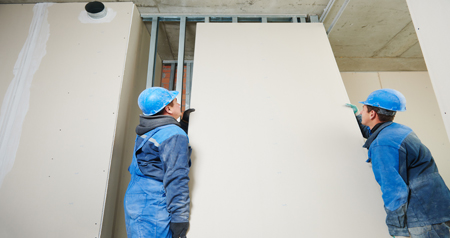
Plasterboard – Life after use
Gypsum board, also referred to as plasterboards, drywall, wallboards and gyprock, is a wall or ceiling panel made of a gypsum core surrounded with a paper lining.
Since 2006 disposal of plasterboard waste with a high sulphate content has not been permitted in general landfill. It can only be landfilled at a site with a mono-cell – a separate cell which only accepts high sulphate waste.
Plasterboards contain calcium sulphate dehydrate. As gypsum breaks down, a toxic hydrogen sulphide gas is created. Whilst the bacteria is killed when exposed to air, the airless, moist landfill sites provide perfect conditions for inhabiting this bacteria. During its breakdown gypsum can release up to a quarter of its weight in hydrogen sulphide gas. In addition to this, methanogenic bacteria will break down the paper sandwiching the plasterboard, and releasing harmful methane gas into the environment. .
Waste from new construction
Waste from new construction generally takes the form of onsite plasterboard off-cuts and typically represents around 15% of the plasterboard used onsite. To reduce this amount, waste producers have started to make ‘made-to-measure’ boards. Unfortunately, the use of these has been limited with very few buyers actually purchasing them. Recycling from new construction waste is referred to as post-consumer recycled gypsum.
Waste from demolition and reconstruction
This is plasterboard which may have been in use for many years and likely to be contaminated with screws, nails, wood, insulation, wall coverings etc. All of these must be fully removed before the plasterboard can be recycled – a process known as decontaminating. Once recycled the plasterboard is known as post-consumer recycled gypsum.
Waste from manufacture
Waste from manufacture generally consists of rejects and non-spec products generated during the manufacturing process. Usually this is recycled within the plant itself as part of its protocol on waste avoidance. Waste recycled in this manner is called production waste derived recycled gypsum.
Gypsum recycled from plasterboard waste is typically used in plasterboard manufacture, cement manufacture and land improvement in agriculture. Recycling one metric ton of gypsum will save 28 kwh of energy and 4lbs of aluminium.
Initiatives to recycle gypsum
Major UK plasterboard manufacturers including British Gypsum, Knauf and Siniat operate waste take back schemes whereby old bags of plasterboard can be exchanged for used plasterboard. Specialist plants will then reprocess this old plasterboard to form new.
There are also smaller local schemes in operation throughout the UK as well as a number of plasterboard recyclers who will accept plasterboard free of charge.
Benefits of recycling gypsum
Recycling gypsum provides a range of advantages.
Firstly, it enables manufacturers to reduce emissions as less energy is used during the process of recycling gypsum than using raw gypsum. Additionally, transportation energy emissions are reduced as a result of less raw, mined gypsum being required, and significant cost savings can be made through selling recycled gypsum. For example, the cost of sending one skip of waste plasterboard to landfill is approximately £2000. As savings of around £500 can be made by sending a similar amount of waste to a collection scheme or gypsum recycle centre, the financial incentive for doing this is apparent. Recycling centres also provide a stable source of high quality materials, saving the need of constantly sourcing suppliers. Furthermore, in an increasingly environmentally conscious climate, a company which is actively seen to have an effective strategy for recycling and reusing waste products will present a responsible environmental image.
Life after recycling
The following examples show how recycled gypsum can be effectively utilised.
New Drywall:
Gypsum can easily be recycled into a new piece of plasterboard. Waste gypsum is sorted and stripped of its paper lining and mixed with new gypsum through the process, resulting in top quality plasterboards – similar to an original non-recycled equivalent.
Cement:
Recycled gypsum can also be used as a major component in the process of cement manufacture, serving to reduce the setting time of the concrete.
Agricultural Products
Recycled gypsum is an excellent fertiliser and enhancement for soil. Not only does gypsum loosen compacted soils, but it also increases water infiltration and adds nutrients such as calcium and sulphur back into the soil. It is therefore a vital addition when promoting sustainability in irrigated soils.
Composting
Compost also benefits from the addition of recycled gypsum through a similar method seen with soil. The compost can extract its required nutrients from the gypsum, and benefit from this natural means of enhancement.
If you have any plasterboard which you are unsure how to dispose of properly, please contact us on 330 0297 3071 or email us, info@tradeskips.com. We will be delighted to arrange safe, reliable and cost effective disposal methods for you.
